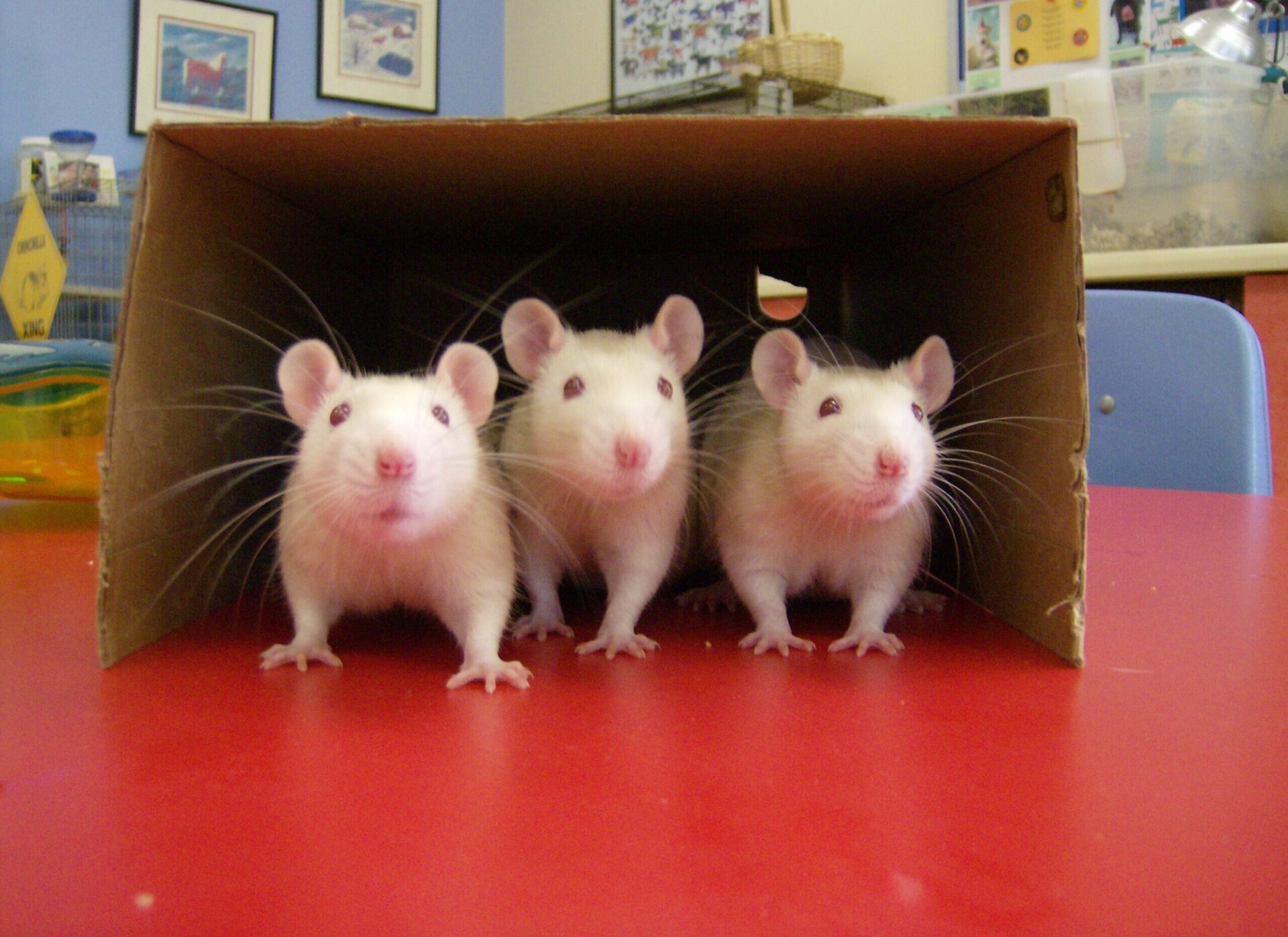
Rats are very social and intelligent creatures and can make excellent pets in the right home. Here are some important things to consider before adopting a rat!
General Considerations:
• Rats teeth grow continually throughout their lifetime. It is important to provide safe enrichment items for them to chew on so that their teeth do not overgrow or malform. Teeth problems in rats can lead to poor nutrition and other health issues.
• Lifespan: Pet rats can live 2-3 years when cared for him a home environment
• Rats are very social creatures. This can make them great pets because they can enjoy the company of their human companions. Many owners have more than one rat. Be sure to have enough space for the number of rats you plan to have. Housing female and male rats together can very easily result in unwanted babies. Some male rats will show dominance toward one another. Be sure to discuss the genders and housing requirements of any rats you are considering adopting with shelter staff.
Housing and Bedding:
• Wire cages can provide a perfect habitat for your pet rats.
• Tall cages with levels allow rats to move about and climb
• Be sure to choose a cage big enough for the number of rats you plan to house
• Avoid cages with wire bottoms as this can cause foot problems and health issues in rats
• Rats are smart – be sure to inspect the cage to make sure all doors close securely
• Rats will need nesting material such as paper (best to avoid newspaper or magazines), tissues, or paper towels, which the rats can use as bedding. Other pet bedding is available such as pelleted products and soft paper-based products
• Avoid cedar and pine wood shavings, but aspen or other hardwood shavings are ok.
• Rats will often choose a designated bathroom area in one part of the cage.
• Spot clean daily and plan for deeper cleaning weekly
Food: Food formulated specifically for rats in pelleted or block form is the best source of nutrition for your pet rat. Follow the instructions on the bag of food for the right feeding amounts. Supplementing with other foods can be a great way to enjoy spending time with yout pet and observing their behavior.
Here are a few choices:
- Fruits – strawberries, apples grapes and bananas
- Vegetables – broccoli, peas, carrot, cooked sweet potato, parsley
- Cooked whole wheat pasta and bread – small portions occasionally
- Cooked beans
- Brown rice
Introduce new foods very gradually to avoid digestive upset. If your rat develops any sign of loose stool, reduce the amount of fresh vegetables and fruit for several days, until digestion returns to normal. Then try reintroducing the food in smaller portions.
Water – Ensure that your rat always has ample supply of fresh water. If they are using a bottle with a spout, rinse and clean the bottle daily. Rats will drink from the bottle with food in their mouths, sending particles of food up into the water bottle. Regular cleanings and fresh water is critical for the health of your rat. For a deep clean, you can use diluted white vinegar and let it soak in the bottle for 30 min. Use a clean bottle brush if you have one. Carefully and thoroughly rinse the bottle and spout and refill with fresh clean water.
Water Bottle Cleaning Trick – If you don’t have a bottle brush, and the inside of the bottle is looking gunky or slimy, fill partway with crushed ice and then add a little diluted white vinegar. Close the bottle and shake vigorously. The crushed ice will scrape the inside of the bottle and help to remove any slime or debris buildup. Rinse thoroughly with fresh water.
Supplies: Your rat will need some fun things to do to keep them entertained safely. Find lots of safe toys at pet supply stores. Always ensure they are meant for rats and don’t contain any toxic ingredients or hazardous materials that could be dangerous for the rat to chew on or ingest. Safe rat chewable toys include wood, apple sticks and some fibers. Be sure to only give your rat items that are safe. Sticking with items from pet supply stores is the best way to ensure your rat’s safety.
Here is a basic list of supplies that most rats will need:
- Enclosure – Safe and secure and big enough for them to move around and get exercise; tall is good
- Water Bottle or bowl – Most rats will drink out of a water bottle with spout.
- Food Bowl – Check that it is shallow enough for your rat to dip their face into
- Igloo or Hidey Hut – Make sure it is big enough for your rat to turn around in. If you are adopting a young rat, they may grow, and you may end up needing a bigger hidey hut.
- Enrichment/Chew Toys – Apple sticks, woven fiber, wooden chew toys are all great options
- Grooming – Small rat nail trimmers, rat shampoo for occasional bathing, brush.
- Bedding – paper or aspen shavings
- Nesting material – shredded paper, tissue, paper towel are good options
- Wheel – You may wish to provide your rat with an exercise wheel. Ensure it is the proper size for your rat. Solid wheels are safest for their feet and tails.
Grooming:
It is best to consult a veterinarian regarding grooming and cleaning for your rat. There are several systems and functions that help a rat keep itself healthy through self-grooming and rats can be quite tidy, especially if you help by keeping their cage clean.
Monitor your rat for any issues, like long nails. Rats don’t require nail trimmings as often as other pet rodents, but you may occasionally need to do this. Check out some YouTube videos of owners trimming their rat’s nails to get a good idea of the best way to do it safely.
Fun and Funny Facts:
• Rats engage in a behavior known as Coprophagia. This means that they consume their own feces. This is totally normal. Many animals do this. Since plant matter is not completely broken down the first time around, rats ingest caecals (a type of stool) to get as many nutrients as possible. This is somewhat similar to how cows chew their cud. Caecals contain essential vitamins, such as vitamin K and B-complex.
• Pet rats can be loving and affectionate
• Pet rats are smart and can be trained using positive reinforcement
• Rat tails are not only used for balance, but also for communicating with other rats and to regulate their internal temperature!


